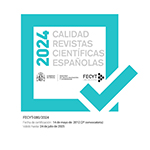Morphological and structural indicators of quality and potential of soil erosion under different land uses in the Ecuadorian Amazon
Abstract
This paper shows the results of the impact of different production systems on the quality and potential erosion of soil resources along two elevational gradients, Napo province, Ecuador. For this purpose, we used multivariate technique structural and morphological parameters evaluation indices soil and by analysis of categorical principal components. In general, soils presented clayey textural classes and silty clay, with predominantly fine materials, which will provide greater susceptibility to different physical degradation processes, such as surface sealing and crusting, erosion, compaction. The analysis of categorical principal component allowed to group production systems based on the elevational gradients and different parameters, indicating that the bulk density, total organic carbon, number of rill and % slope are the variables that define the quality of soil and its erosion potential.Downloads
Article download
License
In order to support the global exchange of knowledge, the journal Anales de Geografía de la Universidad Complutense is allowing unrestricted access to its content as from its publication in this electronic edition, and as such it is an open-access journal. The originals published in this journal are the property of the Complutense University of Madrid and any reproduction thereof in full or in part must cite the source. All content is distributed under a Creative Commons Attribution 4.0 use and distribution licence (CC BY 4.0). This circumstance must be expressly stated in these terms where necessary. You can view the summary and the complete legal text of the licence.












